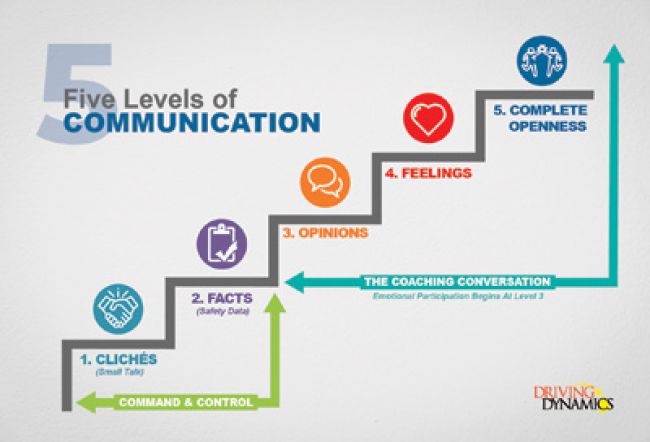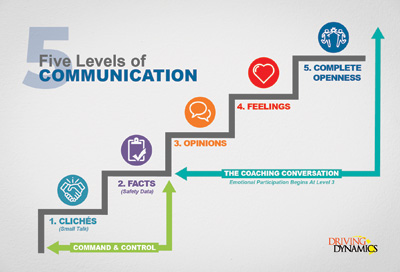
Breaking Down Barriers: Using Data as a Tool in the Driver Safety Communication Process

Utility fleets today have access to a wide variety of valuable data from sources including telematics systems, motor vehicle records and crash statistics, all of which track drivers’ actions behind the wheel. With the vast amount of information available and the efficiency technology offers, it can be tempting to believe instilling safe driving behaviors in your organization’s drivers can be turned into an automated process.
The truth is that you can robotize behavioral change to a certain extent, but if you are using only automated processes, don’t expect them to make any true, long-lasting change. At best you will achieve the most basic level of driver compliance because in this scenario, the driver is not integral to the process but rather just the object of it. And as soon as you pull the plug on any technological monitoring of drivers, expect that evidence of risky driving habits will likely resurface in your next round of risk management reports.
The growing lure to rely almost exclusively on data inputs for managing safety – without including personal and direct involvement from the very drivers you expect to influence – creates a barrier to meaningful progress. It’s one that essentially positions drivers on one side as a problem to be controlled and management on the other side commanding that the drivers comply with the rules. This impersonal approach could lead to more severe incidents and higher crash rates in the future, which could mean increased injuries, fatalities, and revenue loss resulting from payouts and repair costs.
Realistically, the key to effecting positive, lasting behavioral change in your fleet driver population is to put drivers at the center of the process, not the data.
So, where do you start? How do you get there? And where does the data fit in?
Five Levels of Communication for an Effective Coaching Conversation
When a driver has been involved in an incident, you can begin to address needed behavioral change by following a five-level coaching communication process that incorporates data to bolster the discussion.
With each subsequent level, this process moves drivers closer to becoming more aware of their own driving decisions, drawing objective conclusions about their performance, taking ownership of outcomes, and wanting to make positive, long-term changes behind the wheel.
Before you begin a coaching conversation with a driver, keep in mind that the driver may feel apprehensive as to what is about to occur, and perhaps even fearful of losing his or her job. Provide reassurance at the beginning of the conversation that the driver’s safety and well-being are of utmost importance to the organization. Stress that the purpose of the conversation is to work together to gain a better understanding of the driving behaviors that prompted the meeting, and to then identify areas of improvement. These actions will help to put the driver’s mind at ease and set the stage for productive dialogue.
Level 1: Breaking the Ice
The coaching process kicks off when the safety manager initiates a conversation with the driver, beginning with small talk. This helps to break the ice, put the driver at ease and introduce the reason for the coaching session. Through nonjudgmental communication tactics, the manager presents the incident under review. In the example below, the conversation centers around a speeding infraction.
Safety Manager: Hi, Charlie, have a seat. How are you today?
Driver: Hi, Boss, I’m doing well. How are you?
Safety Manager: I’m also doing well. We’re here to talk about your safety behind the wheel. Let’s jump into this traffic infraction and talk about what happened, OK?
Level 2: Getting the Facts
After introducing the issue at hand, the safety manager then seeks out more information from the driver about the circumstances surrounding the incident and why it may have occurred.
First, the safety manager asks the driver to explain his account of what happened. It is important that the manager repeats and confirms the details provided by the driver to ensure mutual understanding. At this point, the manager should also compare the information provided by the driver to available data derived from the company’s telematics system or motor vehicle reports to ensure factual consistency. After listening to the driver’s account and confirming the details, the manager can ask more open-ended questions – which we will cover in the next section – giving the driver an opportunity to further explain and examine his decisions.
When Level 1 and Level 2 are grouped together, they represent what can be described as a command-and-control approach to communication. In organizations where leadership personnel don’t communicate beyond Level 2, a safety manager meets with a driver, produces factual evidence of the driver’s erroneous actions and prescribes remedial training.
But for leaders who quite literally want to take the conversation to the next level, the first two steps of communication help to establish a foundation upon which to build. Once a safety manager navigates through Levels 1 and 2, that’s when true coaching begins to take place.
Level 3: Moving Past Opinions and Perceptions
At Level 3, the conversation shifts to identifying the root cause of the driver’s safety infraction. The safety manager should ask probing, open-ended questions, guiding the driver to think critically about the incident. Following is an example conversation between the safety manager and the driver. Keep in mind that it may take the safety manager several rounds of prompting before getting to the real answers.
Safety Manager: Let’s discuss the speeding ticket you received. Do you have any idea why you missed the speed limit sign?
Driver: I don’t know. It’s the first ticket I’ve gotten in a while.
Safety Manager: Which means?
Driver: I had a slip-up. I’m really upset about it.
Safety Manager: How come?
Driver: It reflects my driving capabilities and concerns me that I’m not paying attention. Now that I think about it, I was talking to the crew in the truck right before I got pulled over.
In this exchange, the driver shares that he was engaged in a conversation with his passengers, which caused him to miss the speed limit sign. The safety manager can see from the information in the motor vehicle report that this wasn’t the first time the driver had been stopped for speeding. The driver’s awareness of why he made the mistake is a great step toward determining the root of the problem, which may have been both poor time management and distracted driving.
Level 4: Starting to Share Feelings
During this level of communication, the driver describes to the safety manager how he is feeling about the incident that transpired. This is the most difficult level because sharing feelings requires personal vulnerability. In our example scenario regarding the speeding infraction, the driver reaches a point during this phase where he feels open to sharing his fear that if he does not begin to pay better attention to traffic signs and signals, he could put himself and his passengers in danger. The driver feels he could even end up in a situation where he’s unable to provide for his family anymore. At this point in the discussion between the driver and the safety manager, the driver has taken a deeper look at the incident and his actions, and he is comfortable expressing his feelings. Connecting feelings to an unsafe driving scenario is crucial because most of the time, a change in behavior stems from an emotional response.
Level 5: Achieving Complete Openness
Level 5 is considered the most intimate level of communication between the driver and safety manager; it is at this level that the two have discussed both facts and feelings. The driver understands how critical it is to always behave in a safe manner behind the wheel and has been able to come to his own conclusion about what adjustments he needs to make. This is also the point at which the driver becomes motivated to initiate his own personal plan of action because he is now fully aware of what could happen if he was to repeat these unsafe driving behaviors.
Conclusion
Engaging in a coaching session that includes this five-step communication process guides drivers to address their poor driving behaviors without feeling defensive and becoming uncommunicative. When communication barriers are broken down using this balanced approach between people and data, safety managers can provide more in-tune coaching efforts, which puts drivers in the best position to keep themselves and others safe on our roadways.
About the Author: Art Liggio, CEO and president at Driving Dynamics (www.drivingdynamics.com), is a risk and insurance management executive with more than 30 years of experience helping fleet-based operations manage risk and mitigate losses.

